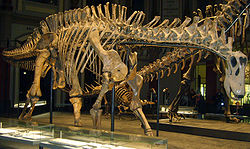- Dicraeosaurus
-
Dicraeosaurus
Temporal range: Late Jurassic, 155–150 Ma
Dicraeosaurus skeleton Scientific classification Kingdom: Animalia Phylum: Chordata Class: Reptilia Superorder: Dinosauria Order: Saurischia Suborder: Sauropodomorpha Family: Dicraeosauridae Genus: Dicraeosaurus
Janensch, 1914Species - D. hansemanni Janensch, 1914 (type)
- D. sattleri Janensch, 1914
Dicraeosaurus (Gr. δικραιος, dikraios "bifurcated, double-headed" + Gr. σαυρος, sauros "lizard") is a genus of small diplodocoid sauropod dinosaur. It was named for the spines on the back of the neck. The first fossil was described by paleontologist Werner Janensch in 1914.
Unlike most diplodocoids, Dicraeosaurus had a large head with a relatively short and wide neck. It also lacked the whiplash tail that other diplodocids had. It was smaller, at only reached 41 feet (12 m) in length. It gets its name, which means two-forked lizard, from the spines that came from the vertebrae. They were not straight as in some members of the family. Each one was “Y” shaped, like a fork. These spines also provided muscle attachment points.[1]
Dicraeosaurus lived in the Late Jurassic. It was herbivorous; however, it didn’t compete with other dinosaurs for vegetation. Fossils have been discovered in the rocks of Tendaguru Hill in Tanzania. The rocks also yield fossils of Giraffatitan and Kentrosaurus. As there was a distinct difference in size between these animals, they would probably have browsed for vegetation at different levels, allowing them to co-exist without significant competition.[1]
References
External links
Categories:- Diplodocoids
- Dinosaurs of Africa
- Jurassic dinosaurs
Wikimedia Foundation. 2010.


